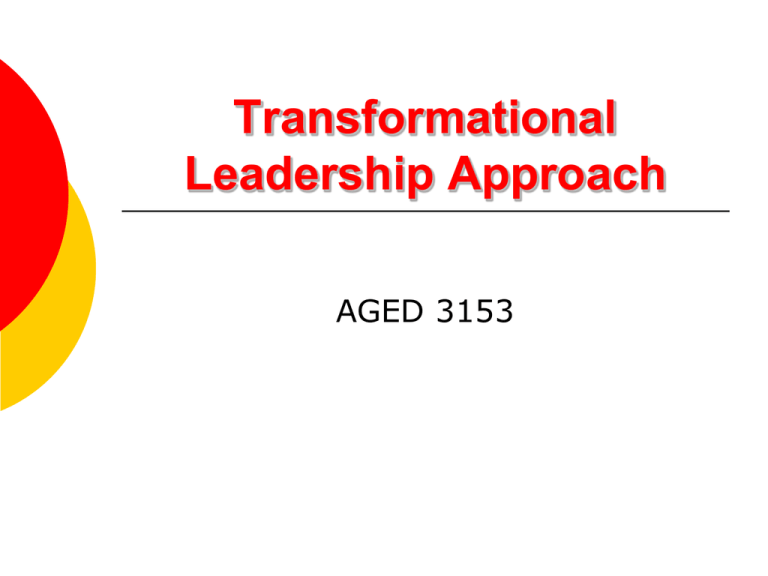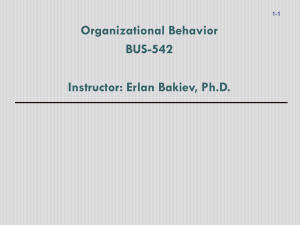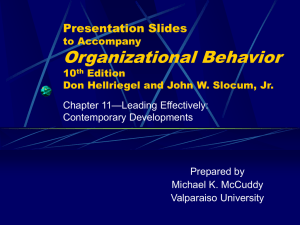Transformational Leadership Approach
advertisement

Transformational Leadership Approach AGED 3153 Be gentle and you can be bold; be frugal and you can be liberal; avoid putting yourself before others and you can become a leader among men. ~ Lao Tzu Overview Transformational leadership approach perspective A model of TL TL factors Full range of leadership model Additive effects of TL Other transformational leadership perspectives How does the transformational approach work? Transactional vs. Transforming Burns Occurs when one person takes the initiative in making contact with others for the purpose of an exchange of valued things Occurs when one or more persons engage with others in such a way that leaders and followers raise one another to higher levels of motivation and morality Pseudotransformational Personalized leadership Describes leaders who are transforming, but in negative ways Leaders who are self-consumed Exploitive Power oriented Warped moral values Examples: Adolf Hitler, Saddam Hussein, Jim Jones Transformational Leadership Approach Description “New leadership” paradigm – 1980s Treats followers as complete human beings assessment of motives satisfying their needs Moves followers to accomplish beyond expectations often incorporates charismatic and visionary leadership Transformational Leadership Approach Description emotions values ethics standards long-term goals Leader plays pivotal role in precipitating change Followers and leaders are bound in the process Types of Leadership Defined Burns (1978) Attempted to link roles of leadership and followership Two types of leadership Transformational Charisma Weber - 1947 Charisma personality characteristic gives superhuman/ exceptional powers reserved for a few is of divine origin person treated as a leader Followers play role in validating charisma House - 1976 theory of charismatic leadership A special gift select individuals possess that gives them the capacity to do extraordinary things Unique personal & behavioral characteristics Model of Transformational Leadership Bass (1985) Expanded and refined original version More attention to followers’ needs Motivates followers beyond the expected by: raising consciousness transcending self-interest addressing higher-level needs Incorporates seven factors Leadership Factors Transformational Factor 1 Idealized Influence Charisma Factor 2 Inspirational Motivational Factor 3 Intellectual Stimulation Factor 4 Individualized Consideration Transactional Factor 6 Mgmt. by Exception Active & Passive Corrective Transactions Factor 5 Contingent Reward Constructive Transactions Nonleadership Factor 7 Laissez-Faire Nontransactional Transformational Leadership Factors 1. Individualized Influence Charisma Describes leaders Inspirational Motivation Inspiration Describes leaders who act as strong role models for followers Leader behaviors: 2. increase moral/ ethical conduct standards Leader behaviors: use symbols/ emotional appeals to focus group “do the right thing” who communicate high expectations provide vision and sense of mission enhanced team spirit Transformational Leadership Factors 3. Intellectual Stimulation Describes leaders Indiv. Consideration stimulate followers to be creative/ innovative Leader behaviors: 4. challenge beliefs and values supports thinking on own careful problem solving Describes leaders provide a supportive climate Leader behaviors: coaching & advising assist individuals in becoming self-actualized use delegation Transformational Leaders Leaders who exhibit TL: have a strong set of values & ideals are effective in motivating followers to support greater good over self-interest Transactional Leadership Factors Management by Exception involves corrective criticism, negative feedback, negative reinforcement Two forms watch followers closely identify mistakes/ rule violations intervenes only after standards have not been met or problems have arisen Contingent Reward exchange process Effort by followers is exchanged for specified rewards Nonleadership Factor Laissez-Faire The absence of leadership. hands-off, let-things-ride approach Refers to a leader who: abdicates responsibility delays decisions gives no feedback makes little effort to help followers satisfy their needs Full Range of Leadership Model Effective II IM IS IC CR Passive MBE LF Ineffective Active Additive Effect of TL Transformational Leadership Individualized Influence + Inspirational Motivation + Intellectual Stimulation + Individualized Consideration Transactional Leadership Contingent Reward + Management by Exception Expected Outcomes Performance Beyond Expectations Other Transformational Perspectives • Bennis & Nanus (1985) Four Leader Transformation Strategies 1. 2. 3. 4. Clear vision of organization’s future state • believable future Social architect of organization • shape/form shared meetings Create trust in organization • make position known and stand by it Creatively deploy themselves through positive selfregard • know strengths & weaknesses and emphasizes strengths Other Transformational Perspectives Kouzes and Posner Five fundamental practices Model the way Inspire a shared vision Challenge the process Enable others to act Encourage the heart How does the transformational leadership approach work? Focus of TL • Describes how leaders can initiate, develop, and carry out significant changes in organizations • Focus of Transformational Leaders empower and nurture followers stimulate change by becoming strong role models for followers create a vision act as change agents are social architects What are the strengths of transformational leadership? What are the weaknesses of transformational leadership? How do we apply transformational leadership? Summary Describes how leaders can initiate, develop, and carry out significant changes in organizations Focus of Transformational Leaders empower and nurture followers stimulate change by becoming strong role models for followers create a vision act as change agents are social architects Summary Two types of leadership Transactional Transformational Treats followers as complete human beings Moves followers to accomplish beyond expectations often incorporates charismatic and visionary leadership Summary Motivates followers beyond the expected by: raising consciousness transcending self-interest addressing higher-level needs









